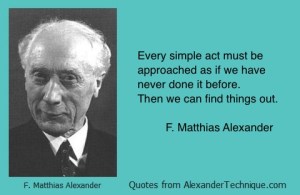I was introduced to the term brachiation a few months ago by my colleague Ellen Stafford, an Alexander Technique teacher in Pittsburgh, Pennsylvania in one of her blog posts, Everyday Poise: Brachiation
Ellen is interested in the evolutionary development of humans, and what we can learn by observing other primates. In particular, she used this short video of a gibbon swinging through the trees to make an important point:
Here’s a little of what she wrote:
The term “brachiation” is derived from the Latin word for arm – brachium – and refers to swinging through the trees using only the arms. Children on monkey bars in a playground are technically practicing brachiation, and research suggests that we humans may have had an arboreal ancestor who traveled through the trees using this technique. If you look closely, you’ll notice that the gibbon reaches for the next branch with the outside edge of his hand and arm – the first thing to grasp the branch is his little finger. This reaching with the outside edge of the hand is one of the defining characteristics of brachiation, and it seems to be one of the major techniques that we humans have lost in descending from the trees. When we reach for something, we usually extend our index finger and thumb towards it. Why would a primate reach with the little finger, rather than the index finger and thumb as we humans do?
I found this fascinating and started exploring the possibilities of consciously extending my little finger to reach objects, and making it the leading edge of arm movements when walking. I also explored leading with the little finger with arm moments while swimming.
I was amazed by what I found. It produced a smoother, more efficient movement every time. You can easily try this yourself.
Naturally I started experimenting on my students, and found they had the same experiences. One student, an older lady who had great difficulty reaching objects on high shelves, found this task had become much easier.
Another student, an avid swimmer like myself, said it totally transformed his swimming form, giving him greater speed and power.
A violist I’ve been working with found it made a huge difference in how she used her hands and arms when playing, giving her greater ease and flexibility.
Even standing became more expansive when I shifted from just standing as I do habitually to gently focusing on my little fingers as the leading edge of my hand releasing down. That’s another experiment you can try right now!
A particular bonus for me was that this could easily be taught via Skype during my Posture and Movement Coaching sessions.
Here’s a podcast I did with Imogen Ragone on the topic that talks you through some of these experiments:
I’ll leave the final words on the topic to Ellen:
It may surprise you to learn that the strongest part of the hand is actually the pinkie-side, not the thumb. The muscles of the little finger connect through to muscles in the outside of the forearm much more strongly than those of the thumb side, meaning that the pinkie-side of the hand has a much more direct connection to the support muscles of the back and scapula. If all you’ve got supporting you is your hand, you’re better off grasping with the pinkie – it’ll give you a much more stable hold. This is the reason why martial artists who use weapons hold the weapon most tightly with the pinkie and most loosely with the index finger – it’s a stronger and more stable hold. Incidentally, martial artists refer to this hold as the “monkey grasp” – and no, that’s not a coincidence.
This concept of brachiation can be extremely useful for humans, particularly when reaching for an item above head level. By reaching with the pinkie first, we can keep the shoulders released and the support muscles of the back engaged, allowing for better control of the object once picked up. Just as it’s easier to carry a heavy load by getting underneath it than by hauling straight up from above, reaching with the pinkie connects through to the back and allows the muscles of the scapula to do the work from underneath, rather than relying on the upper deltoids to haul up from the top of the shoulders. This not only makes it easier to lift the weight in question, it also makes it easier to lift the weight of the arm itself.
Next time you go to a zoo, take a trip through the primate house and keep an eye out for brachiation. Watch how easily they move through their habitats, and look for the pinkie-side of the hand!
Please share your experiences in the comment box below and/or on Facebook.
***
I owe the title of this blog to Katie Fittipadi, an Alexander Technique teacher in Rochester, New York.
Image courtesy of tungphoto at FreeDigitalPhotos.net











